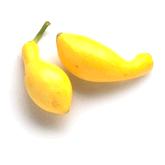|
|
Glossary Selection
Yam | |||
| Yam is the common name for members of the genus Dioscorea (family Dioscoreaceae). There are more than 150 different varieties of yam. Some species are cultivated for the consumption of their starchy tubers in Africa, Asia, Latin America and Oceania. The word yam comes from Portuguese inhame or Spanish ñame, which both ultimately derive from the Wolof word nyami, meaning "to eat". They are used in a similar fashion to potatoes, and are sometimes called a potato substitute, though in areas where yams are grown, potatoes are the newer vegetable. Yam tubers can grow up to seven feet (approx. two meters) in length and weigh up to 150 pounds (68 kg). The yam has a rough skin which is difficult to peel, but which softens after heating. Yam skins vary in color from dark brown to light pink. The majority of the yam is composed of a much softer substance known as the "meat". This substance ranges in color from white to bright orange in ripe yams. Yams are a primary agricultural commodity in West Africa and New Guinea. They were first cultivated in Africa and Asia about 8000 B.C., probably because they were able to flourish in environments where growing leafy vegetables and keeping livestock was difficult. To this day, the yam tuber remains crucial to survival in the region; it can be stored for four to six months without refrigeration, which makes it a valuable resource for the yearly period of food scarcity at the beginning of the wet season. | |||
Yalanci Dolma | |||
| vine leaves stuffed with rice, onions, and tomatoes | |||
Yayla Soup | |||
| Soup of the pastures | |||
Yellow Crookneck squash | |||
 | Yellow crookneck squash (Cucurbita pepo) is a type of yellow-coloured vegetable marrow and is a member of the gourd family. It is also known as Summer Squash, Pattypan Squash, and Straightneck Squash. It has mildly sweet and watery flesh, and thin tender skins that for many recipes don't need to be peeled off. It was almost certainly domesticated in the eastern U.S., although other variants of the same species (zuchini, pumpkin) were domesticated in Mesoamerica. The squash grows on vined plants reaching 60 to 90 cm in height that thrive in mild weather. It is well known as an item in American cooking, and is often used in recipes interchangeably with zucchini in which it is fried, microwaved, steamed, or baked. When selecting this variety of squash in a store, chose those that are small and firm with tender skins free of blemishes or bruising. Yellow crookneck squash is available all year long in some regions, but it is at its peak from early through late summer. | ||
Youngberry | |||
| The youngberry is a hybrid of a blackberry and a dewberry grown in western and southern U.S. | |||
Yosenabe | |||
| Nabemono refers to a class of Japanese dishes known as one pot dishes. Nabe means cooking pot. Traditionally, this was a clay pot cooked over a fire. Cooking fires are rare in modern Japan but traditional clay nabe continue to be used for preparing one-pot meals. Mono means thing or things or stuff. Thus, nabemono means things cooked together in a nabe pot (c.f., nimono [simmered things] and yakimono [grilled things]). Nabemono is also sometimes called just nabe. The most popular nabemono is called yosenabe. Yose means putting together. The name thus implies that all things (e.g., meat, fish, egg, tofu and vegetables) are cooked together in the pot. Yosenabe are typically based on a broth made with miso or soy sauce flavourings | |||
Yarrow | |||
| Yarrow has also been used as a food, and was very popular as a vegetable in the 17th century. The younger leaves are said to be a pleasant leaf vegetable when cooked as spinach, or in a soup. Yarrow is sweet with a slight bitter taste. | |||
Yakimono | |||
| The Japanese term for dishes that are grilled and pan-fried. | |||
Yakitori | |||
| It is a grilled chicken, is a Japanese type of chicken kebab | |||
Yard-long bean | |||
| Dark green pods are 14-24 inches long with firm texture that are well flavored. This variety is suitable for growing in tropical areas, adapting to heat and rain very well. The plant is later maturing and high yielding, very popular in Southern China. | |||




